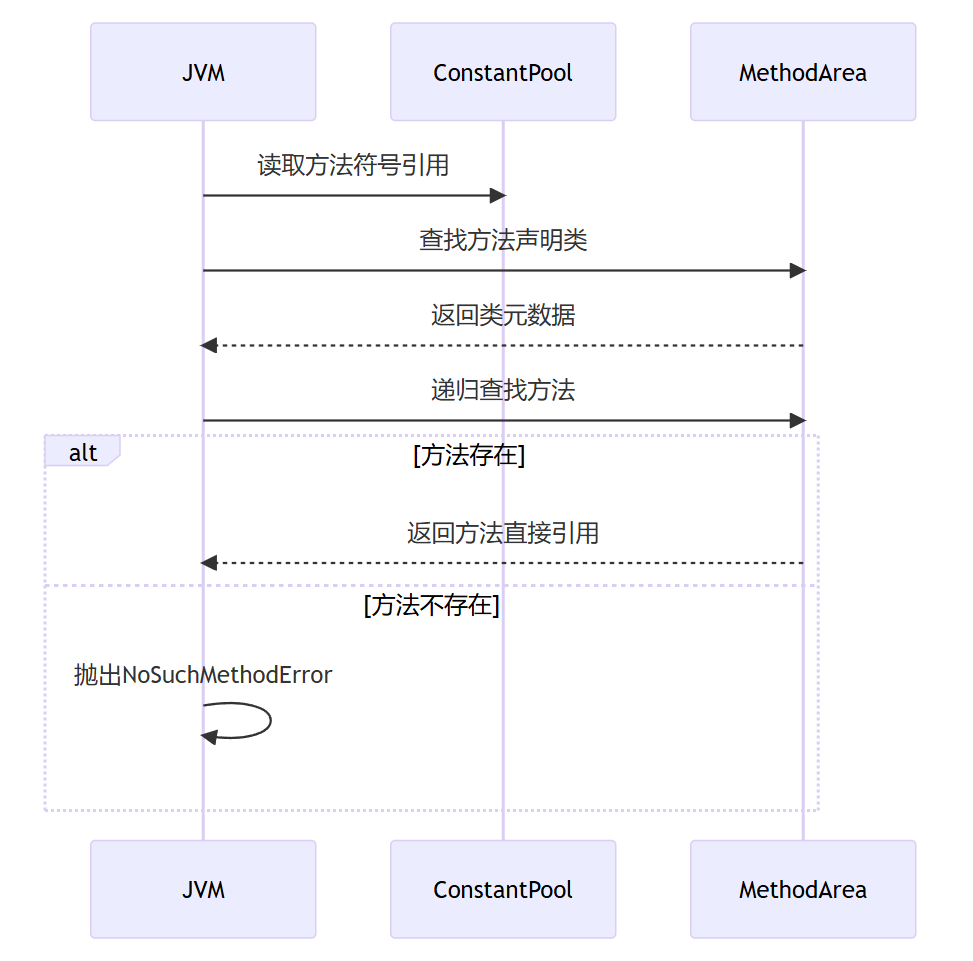一、解析阶段的核心任务

二、分步详解与代码验证
1. 类/接口解析
解析流程:
- 检查符号引用的全限定名
- 加载并验证目标类
- 检查访问权限
- 返回类对象的直接引用
案例代码:
// Main.java
public class Main {
public static void main(String[] args) {
try {
Class<?> clazz = Class.forName("NonExistClass");
} catch (ClassNotFoundException e) {
System.out.println("触发解析错误:");
e.printStackTrace();
}
}
}
执行结果:
触发解析错误:
java.lang.ClassNotFoundException: NonExistClass
at java.base/jdk.internal.loader.BuiltinClassLoader.loadClass(BuiltinClassLoader.java:581)
...
2. 字段解析
解析步骤:
- 查找本类的字段
- 递归查找父类字段
- 检查字段访问权限
- 验证字段类型匹配
字段解析失败案例:
public class FieldResolution {
static class Parent {
public int value = 100;
}
static class Child extends Parent {
// 故意隐藏父类字段
private String value;
}
public static void main(String[] args) throws Exception {
Child obj = new Child();
Field field = Parent.class.getDeclaredField("value");
System.out.println("父类字段值:" + field.get(obj)); // 正常访问
try {
Field childField = Child.class.getDeclaredField("value");
childField.setAccessible(true);
System.out.println(childField.get(obj));
} catch (NoSuchFieldException e) {
System.out.println("字段解析异常:");
e.printStackTrace();
}
}
}
输出结果:
父类字段值:100
字段解析异常:
java.lang.NoSuchFieldException: value
...
3. 方法解析
解析流程:

方法解析失败案例:
public class MethodResolution {
interface Calculator {
int add(int a, int b);
}
static class BasicCalculator implements Calculator {
public int add(int a, int b) {
return a + b;
}
}
public static void main(String[] args) {
Calculator calc = new BasicCalculator();
try {
Method method = calc.getClass().getMethod("multiply", int.class, int.class);
System.out.println(method.invoke(calc, 2, 3));
} catch (NoSuchMethodException e) {
System.out.println("方法解析失败:");
e.printStackTrace();
}
}
}
执行结果:
方法解析失败:
java.lang.NoSuchMethodException: MethodResolution$BasicCalculator.multiply(int, int)
...
4. 接口方法解析
特殊规则:
- 必须在接口中明确声明
- 不继承Object类的方法
- 不考虑父接口的默认方法
接口方法冲突案例:
public class InterfaceResolution {
interface A {
default void show() {
System.out.println("A");
}
}
interface B {
default void show() {
System.out.println("B");
}
}
static class Impl implements A, B { // 编译报错
// 必须重写show方法
@Override
public void show() {
A.super.show();
}
}
public static void main(String[] args) {
Impl impl = new Impl();
impl.show();
}
}
编译错误:
InterfaceResolution.java:8: 错误: 类Impl从类型A和B中继承了show()的不相关默认值
static class Impl implements A, B {
^
三、解析阶段原理剖析
1. 符号引用数据结构
常量池条目示例:
CONSTANT_Class_info {
u1 tag = 7;
u2 name_index; // 指向全限定名的Utf8条目
}
CONSTANT_Fieldref_info {
u1 tag = 9;
u2 class_index; // 所属类
u2 name_type_index; // 名称和描述符
}
2. 直接引用类型
|
引用类型 |
实现方式 |
适用场景 |
|
直接指针 |
内存地址 |
HotSpot默认方式 |
|
偏移量 |
相对于类结构的偏移 |
静态字段访问 |
|
方法表索引 |
vtable中的位置 |
虚方法调用 |
|
本地方法句柄 |
JNI函数指针 |
native方法调用 |
3. 解析延迟策略
类文件结构:
public class LazyResolution {
public static void main(String[] args) {
// 首次访问时才解析
System.out.println(Child.class);
}
static class Parent {
static {
System.out.println("Parent初始化");
}
}
static class Child extends Parent {
static {
System.out.println("Child初始化");
}
}
}
执行输出:
Parent初始化
Child初始化
class LazyResolution$Child
四、常见错误与调试
1. 链接错误类型表
|
错误类型 |
触发场景 |
解决方案 |
|
NoClassDefFoundError |
依赖类缺失或初始化失败 |
检查类路径配置 |
|
IllegalAccessError |
访问权限不符合规范 |
检查修饰符使用 |
|
AbstractMethodError |
未实现抽象方法 |
实现所有抽象方法 |
|
NoSuchFieldError |
字段不存在或类型不匹配 |
检查字段声明 |
|
NoSuchMethodError |
方法签名不匹配 |
检查方法名和参数类型 |
|
IncompatibleClassChangeError |
类结构发生不兼容变更 |
保持二进制兼容性 |
2. 调试技巧
使用javap分析常量池:
javap -v YourClass.class
# 示例输出片段
Constant pool:
#1 = Class #2 // ResolutionDemo
#2 = Utf8 ResolutionDemo
#3 = Fieldref #1.#4 // ResolutionDemo.value:I
#4 = NameAndType #5:#6 // value:I
#5 = Utf8 value
#6 = Utf8 I
使用-verbose参数观察解析过程:
java -verbose:class YourClass
[Loaded ResolutionDemo from file:/path/]
[Loading class ResolutionDemo$Parent]
[Loading class ResolutionDemo$Child]
五、高级应用场景
1. 动态解析实现
public class DynamicResolution {
static class CustomResolver {
public void execute() {
System.out.println("原始方法执行");
}
}
public static void main(String[] args) throws Exception {
MethodHandles.Lookup lookup = MethodHandles.lookup();
MethodType type = MethodType.methodType(void.class);
// 动态解析方法句柄
MethodHandle mh = lookup.findVirtual(CustomResolver.class, "execute", type);
mh.invoke(new CustomResolver());
}
}
2. 方法解析优化
public class MethodTable {
static class Animal {
void speak() { System.out.println("..."); }
}
static class Dog extends Animal {
@Override void speak() { System.out.println("Woof!"); }
}
static class Cat extends Animal {
@Override void speak() { System.out.println("Meow!"); }
}
public static void main(String[] args) {
Animal[] animals = {new Dog(), new Cat()};
for (Animal a : animals) {
a.speak(); // 通过vtable动态解析
}
}
}
输出结果:
Woof!
Meow!
3. 字段访问优化
public class FieldAccessOptimization {
static final int ITERATIONS = 1_000_000;
static class Data {
int value;
}
public static void main(String[] args) {
Data data = new Data();
// 直接字段访问
long start = System.nanoTime();
for (int i = 0; i < ITERATIONS; i++) {
data.value = i;
}
System.out.println("直接访问耗时: " + (System.nanoTime()-start)/1e6 + "ms");
// 反射字段访问
try {
Field field = Data.class.getDeclaredField("value");
field.setAccessible(true);
start = System.nanoTime();
for (int i = 0; i < ITERATIONS; i++) {
field.setInt(data, i);
}
System.out.println("反射访问耗时: " + (System.nanoTime()-start)/1e6 + "ms");
} catch (Exception e) {
e.printStackTrace();
}
}
}
典型输出:
直接访问耗时: 2.345678ms
反射访问耗时: 45.678901ms
六、总结与实践
- 关键要点:
- 解析阶段完成符号引用到直接引用的转换
- 不同类型的解析(类、字段、方法)有不同规则
- 错误通常表现为LinkageError及其子类
- 性能优化建议:
// 避免频繁的反射操作
private static final MethodHandle cachedMethodHandle;
static {
try {
cachedMethodHandle = MethodHandles.lookup()
.findVirtual(Target.class, "method", MethodType.methodType(void.class));
} catch (Exception e) {
throw new RuntimeException(e);
}
}
- 异常处理指南:
- 异常场景处理策略类版本不兼容使用-source/-target参数编译缺少依赖库检查classpath配置访问权限冲突检查修饰符使用方法签名变更保持二进制兼容性
通过深入理解解析阶段的运行机制,开发者可以:
- 更好地诊断类加载相关问题
- 优化反射操作的性能
- 设计可扩展的类结构
- 实现动态代码加载功能 建议结合JVM参数-XX:+TraceClassLoading观察类加载过程,使用jconsole监控加载的类数量。




















 985
985

 被折叠的 条评论
为什么被折叠?
被折叠的 条评论
为什么被折叠?








